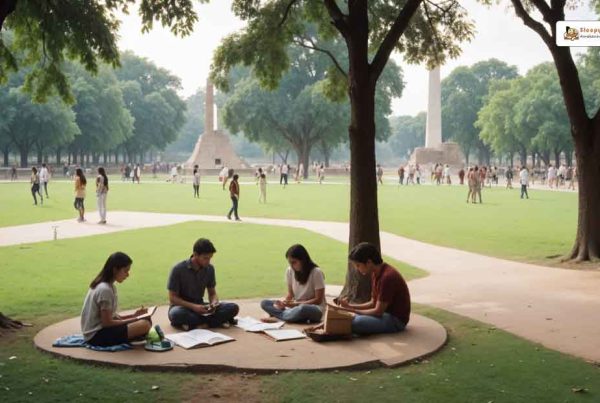The reservation system in India is a way to help underrepresented groups get fair chances in education, jobs, and other areas. This system started a long time ago, and it has changed over the years. It aims to fix past wrongs and make society fairer for everyone.
Key Takeaways
- The reservation system in India aims to provide fair opportunities to underrepresented groups.
- It has its roots in the ancient caste system and has evolved over time.
- The Mandal Commission played a significant role in shaping modern reservation policies.
- Legal cases like the Indra Sawhney case have had a big impact on how reservations work.
- There are ongoing debates and controversies about the effectiveness and fairness of the reservation system.
Historical Context of the Reservation System
The reservation system in India has deep roots in the country’s history, evolving through various phases to address social inequalities. Persistent discrimination and prejudice against certain communities have long contributed to the demand for reservations. These policies aim to promote social and economic progress by offering opportunities for upward mobility and breaking the cycle of disadvantage.
Ancient Caste System and Social Hierarchy
The origins of the reservation system can be traced back to the ancient caste system, which created a rigid social hierarchy. This system categorized people into different groups, often leading to systematic discrimination and exclusion of lower castes from various social and economic activities.
Colonial Era Policies and Their Impact
During the colonial era, the British introduced policies that further entrenched caste divisions. In 1882, the concept of reservation based on caste was first proposed. By 1909, the British had implemented measures that recognized caste as a basis for political representation, laying the groundwork for future reservation policies.
Post-Independence Constitutional Provisions
After gaining independence, India sought to address these historical injustices through its Constitution. The framers of the Constitution included provisions for reservations to ensure equal security for all communities, with special consideration given to Scheduled Castes (SCs) and Scheduled Tribes (STs). These measures were founded on the principles of deprivation and rectification, aiming to uplift marginalized groups and provide them with better opportunities in education and employment.
The reservation policy in India is a testament to how politics can drive social change, aiming to rectify historical injustices and promote equality.
The Role of the Mandal Commission
Formation and Objectives
The Mandal Commission was established in 1979 by the Indian government to identify the socially and educationally backward classes (SEBCs) in India. The commission was primarily responsible for addressing the challenges the Other Backward Classes (OBCs) encountered. It had to establish what criteria would be used to categorize people as being a step behind in society. The commission’s main goal was to ensure that these groups received fair treatment and opportunities in education and employment.
Key Recommendations
The Mandal Commission submitted its report in 1980, recommending a 27% reservation for OBCs in government jobs and educational institutions. This was in addition to the existing 22.5% reservation for Scheduled Castes (SCs) and Scheduled Tribes (STs). The report highlighted the need for affirmative action to uplift the backward classes and reduce social inequality. One of the key recommendations was to implement these reservations to improve the socio-economic status of the OBCs.
Impact on Indian Society
The implementation of the Mandal Commission’s recommendations in 1990 led to significant changes in Indian society. It sparked widespread protests and debates, especially among those who felt that reservations based on caste were unfair. Despite the controversies, the commission’s work brought attention to the issues faced by the OBCs and led to increased representation of these groups in government jobs and educational institutions. The Mandal Commission’s report and caste-based reservation policies continue to influence India’s social and political landscape.
Legal Milestones in Reservation Policies
Indra Sawhney Case and Its Implications
The landmark judgment, Indra Sawhney vs. Union of India, decided in 1992 by the Supreme Court, addressed the complex issue of reservations in government jobs and education for Other Backward Classes (OBCs). This case upheld the government’s decision to provide 27% reservation for OBCs but introduced the concept of the “creamy layer,” which excluded the more affluent members of OBCs from availing these benefits. This judgment set a precedent by capping reservations at 50% and emphasized that caste could be a valid indicator of social and educational backwardness.
Supreme Court Verdicts on Reservation
Over the years, the Supreme Court has delivered several important verdicts on reservation policies. These rulings have shaped the implementation and scope of reservations in India. For instance, the Court has consistently upheld the exclusion of the creamy layer among OBCs and has extended this principle to Scheduled Castes (SCs) and Scheduled Tribes (STs) in certain contexts. Additionally, the Court has ruled that reservations cannot be applied in promotions, reinforcing the idea that once individuals from disadvantaged groups are brought to an equal footing, further benefits in promotions would be unjust.
Constitutional Amendments Related to Reservation
Several constitutional amendments have been made to address and refine reservation policies in India. These amendments have aimed to balance the need for social justice with the principles of equality and meritocracy. Notably, the 77th Amendment Act of 1995 allowed for reservations in promotions for SCs and STs, while the 103rd Amendment Act of 2019 introduced a 10% reservation for economically weaker sections (EWS) of the general category. These amendments reflect the evolving nature of reservation policies and the ongoing efforts to ensure that they serve the intended purpose of uplifting marginalized communities.
Reservation in Education
Policies for Scheduled Castes and Scheduled Tribes
Reservation helps in providing the same level of playing field to every citizen of the country. It helps socially and educationally backward sections of society who are deprived of money, education, and other resources. Without reservation, it was nearly impossible for them to match with the rest of society.
Reservation for Other Backward Classes
Reservation is a proactive measure that allows historically disadvantaged communities access to government programmes, scholarships, and political engagement in India. The Union Government and the States and Territories of India are entitled to set reserved quotas or seats in educational admissions, employments, political entities, promotions, etc. in accordance with stipulations in the Indian … [Show full abstract] Constitution. Affirmative action scheme called reservation allows historically
Impact on Higher Education
should be applied in a logical and systematic way. Despite being conscious of reservation policy, access to education remains a significant barrier.
Reservation in Employment
Reservation is a proactive measure that allows historically disadvantaged communities access to government programs, scholarships, and political engagement in India. The Union Government and the States and Territories of India are entitled to set reserved quotas or seats in educational admissions, employments, political entities, promotions, etc. in accordance with stipulations in the Indian Constitution. Affirmative action scheme called reservation allows historically disadvantaged communities access to government programs, scholarships, and political engagement in India.
Economic Criteria and the Creamy Layer Concept
Definition and Evolution of the Creamy Layer
The term creamy layer refers to members of a backward class who are socially, economically, and educationally advanced compared to the rest of their community. This concept was first introduced in the 1992 Indra Sawhney case, where the Supreme Court ruled that the advanced section among the Other Backward Classes (OBCs) should be excluded from reservation benefits. This principle ensures that the benefits of reservation reach those who genuinely need them.
Economic Criteria vs. Social Backwardness
The creamy layer principle is based on economic criteria, distinguishing it from social backwardness. While social backwardness is determined by caste and community, the creamy layer focuses on income and wealth. This distinction has sparked debates on whether economic criteria alone can address the complexities of social inequality.
Supreme Court Rulings on the Creamy Layer
The Supreme Court has played a crucial role in shaping the creamy layer concept. In the 1992 Indra Sawhney case, the Court established the creamy layer exclusion for OBCs but ruled that it should not apply to Scheduled Castes (SCs) and Scheduled Tribes (STs). Over the years, the Court has reaffirmed this principle, emphasizing that the creamy layer should be excluded to ensure that reservation benefits reach the truly disadvantaged.
State-Specific Reservation Policies
Tamil Nadu has one of the most extensive reservation systems in India. The state provides a high percentage of reservations for various communities, including Scheduled Castes (SC), Scheduled Tribes (ST), and Other Backward Classes (OBC). The reservation policy in Tamil Nadu is unique because it exceeds the 50% cap set by the Supreme Court. This model has been both praised for its inclusivity and criticized for potentially undermining meritocracy.
Bihar has a different approach to reservations compared to Tamil Nadu. The state focuses on providing reservations not just in education and employment but also in local governance. Bihar’s policies aim to uplift marginalized communities by ensuring their representation in Panchayati Raj institutions. This approach has led to significant social changes, although challenges remain in fully implementing these policies.
When comparing the reservation policies of Tamil Nadu and Bihar, several differences and similarities emerge:
- Percentage of Reservation: Tamil Nadu offers a higher percentage of reservations compared to Bihar.
- Scope: Bihar extends reservations to local governance, while Tamil Nadu focuses more on education and employment.
- Impact: Both states have seen social changes due to their reservation policies, but the effectiveness varies.
The diversity in state-specific reservation policies highlights the complexity and regional variations in addressing social justice in India.
Gender and Reservation
Reservation for Women in Education and Employment
In India, reservation policies have been extended to women to promote gender equality. A 33% reservation in local government bodies has been proposed to ensure better political representation of women. This move aims to bridge the gap and ensure a more equitable representation of women in various sectors.
Transgender and Non-Binary Inclusion
The inclusion of transgender and non-binary individuals in reservation policies is a recent development. This step is crucial for promoting gender equality and ensuring that all individuals, regardless of their gender identity, have access to opportunities in education and employment.
Impact on Gender Equality
Reservation policies for women and transgender individuals have had a significant impact on gender equality in India. These policies have helped in increasing the participation of women in education and employment, thereby promoting a more inclusive society.
Promoting gender equality and ensuring equitable representation in various sectors is essential for the overall development of society.
Criticism and Controversies
Mandal Commission Protests
The Mandal Commission’s recommendations in 1990 led to widespread protests across India. Many people felt that the reservation system was unfair and would harm merit-based opportunities. The protests were intense, with students and professionals taking to the streets. Some even resorted to self-immolation to show their opposition.
Anti-Reservation Movements
In 2006, another wave of protests erupted against the reservation policies. These movements were driven by the belief that reservations were creating a mismatch in skills and affecting the quality of education and employment. Critics argued that the system was not addressing the root causes of social inequality.
Debates on Meritocracy vs. Social Justice
One of the most heated debates around the reservation system is the balance between meritocracy and social justice. Opponents argue that reservations compromise meritocracy, while supporters believe they are essential for social justice. This debate continues to be a significant point of contention in Indian society.
The reservation system has been criticized for potentially compromising meritocracy. This ongoing debate highlights the complexities of balancing social justice with individual merit.
Future of Reservation Policies in India
Proposed Reforms and Changes
The future of reservation policies in India is a topic of ongoing debate and discussion. Proposed reforms often focus on balancing social justice with meritocracy. Some suggest that reservations should be based on economic criteria rather than solely on caste. This shift could help address the needs of economically disadvantaged individuals across all communities.
Public Opinion and Political Will
Public opinion on reservation policies is divided. While some believe that reservations are essential for social equity, others argue that they undermine merit. The political will to implement changes is crucial. Politicians often face the challenge of balancing the demands of different voter groups while ensuring that policies are fair and just.
Long-Term Impact on Indian Society
The long-term impact of reservation policies on Indian society is complex. On one hand, reservations have helped uplift marginalized communities by providing them with opportunities in education and employment. On the other hand, there are concerns about the potential for social division and the perpetuation of caste-based identities. The future will likely see a continued evolution of these policies to better serve the needs of a diverse and changing society.
The future of reservation policies in India will depend on a delicate balance between social justice and meritocracy, requiring thoughtful reforms and strong political will.
The future of reservation policies in India is a topic of great importance and debate. As the country evolves, so do the needs and expectations of its people. To stay informed and understand the potential changes, visit our website for in-depth articles and expert analysis. Don’t miss out on the latest updates and insights!
Conclusion
The reservation system in India has a long and complex history, rooted in the need to address social inequalities and provide opportunities for historically marginalized communities. Over the years, it has evolved through various legal and political challenges, reflecting the changing dynamics of Indian society. While it has been successful in creating opportunities for many, it has also sparked debates and controversies. Understanding its origins and development helps us appreciate the ongoing efforts to balance social justice with equality. As India continues to grow and change, the reservation system will likely remain a crucial, yet contentious, part of its social fabric.
Frequently Asked Questions
What is the reservation system in India?
The reservation system in India is a way to provide certain groups with a set percentage of seats in government jobs, educational institutions, and legislatures. This is done to help groups that have faced historical injustices due to their caste or social status.
Why was the reservation system introduced in India?
The reservation system was introduced to correct historical wrongs and provide equal opportunities to underprivileged communities. It aims to ensure that these groups have better access to education, jobs, and political representation.
What is the Mandal Commission?
The Mandal Commission was formed in 1979 to identify socially or educationally backward classes in India. It recommended that 27% of government jobs and educational seats be reserved for Other Backward Classes (OBCs).
What is the ‘creamy layer’ in the context of the reservation system?
The ‘creamy layer’ refers to the wealthier and more educated members of the OBCs who are excluded from reservation benefits. This concept ensures that the benefits reach the truly disadvantaged members of these communities.
How does the reservation system affect education in India?
The reservation system ensures that a certain percentage of seats in educational institutions are reserved for Scheduled Castes (SCs), Scheduled Tribes (STs), and Other Backward Classes (OBCs). This helps these communities gain better access to higher education.
Is there a reservation for women in India?
Yes, there are reservations for women in certain areas like local government bodies. Efforts are also being made to increase their representation in education and employment.
What are the criticisms of the reservation system?
Critics argue that the reservation system can undermine meritocracy and lead to divisions in society. Some also believe that it benefits only a small section of the intended groups while leaving out others who are equally in need.
What is the future of the reservation system in India?
The future of the reservation system is a topic of ongoing debate. Some propose reforms to make it more effective, while others call for its removal. Public opinion and political will play significant roles in shaping its future.





